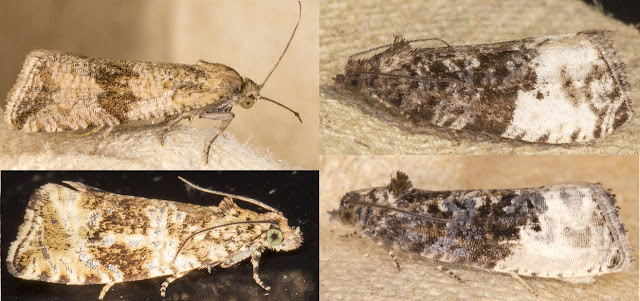 |
| Tortricidae in the West Wickham Common light trap. Lozotaenia forsteriana; Green Oak Tortrix, Tortrix viridana; Barred Fruit-tree Tortrix, Pandemis cerasana. 29 June 2013. |
Tortrixes are usually easily recognised because of their shapes. Some sit flat like this, others with tented wings. Some are very common - on Sunday I shook the branch of an oak tree and a flock of Green Oak Tortrixes flew out. They are quite small, mostly between 1 and 2 cm long.
As with many moths named after plants, their caterpillars don't restrict themselves to their namesakes. The Green Oak Tortrix also eats Beech - though it is very common on Oaks, and the small green caterpillars are often seen dangling by a thread where branches overhang paths. The Barred Fruit-tree Tortrix will also eat non-fruit trees. Lozotaenia forsteriana doesn't eat any trees, but lives on Ivy and Honeysuckle, both very common in deciduous woodlands.
Here are four of the tented-wing types from the same trap.
Celypha striana eats Dandelions. Celypha lacunana, with its distinguishing silver-grey streaks, eats a range of herbaceous plants. The two on the right will eat fruit trees, but the Plum Tortrix will also go for Blackthorn and the Marbled Orchard Tortrix likes Hawthorn.
To tell those two apart by eye, look at the dividing line between dark and light. The Marbled Orchard Tortrix always has two dark dots arranged vertically under the diagonal. The Plum Tortrix has one or two dots out beyond the diagonal. These two moths imitate bird droppings, and can be quite convincing from a little further away than this.

No comments:
Post a Comment